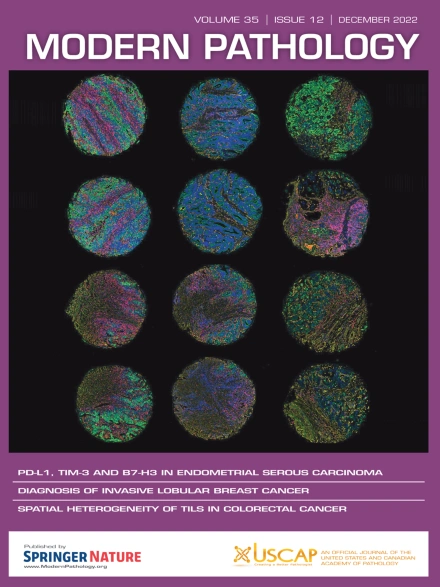Diffuse Cyclin D1 and SPINK1 Expression in Gastric Oxyntic Gland Neoplasms: Promising Diagnostic Markers Identified Using Spatial Transcriptome Analysis
IF 7.1
1区 医学
Q1 PATHOLOGY
引用次数: 0
Abstract
Oxyntic gland neoplasms typically arise in Helicobacter pylori–naive stomachs and are composed predominantly of chief cells, with a smaller component of parietal cells. Their pathologic diagnosis can be challenging owing to minimal cellular atypia. Especially in biopsy specimens with a limited tumor volume or when pathologists have limited experience in diagnosing this neoplasm, distinguishing them from normal oxyntic glands can be difficult, and no reliable diagnostic markers are currently available. In this study, single-cell spatial transcriptome analysis successfully identified significant upregulation of CCND1 and SPINK1 in all 6 analyzed cases of oxyntic gland neoplasms compared with normal oxyntic glands. Immunohistochemical analysis confirmed this finding in 21 endoscopically resected cases of oxyntic gland neoplasms, demonstrating that cyclin D1 and serine peptidase inhibitor Kazal type 1 (SPINK1) were diffusely expressed in oxyntic gland neoplasms, whereas their expression was scarcely observed in normal oxyntic glands, with a few of them showing weak to moderate staining. Even in biopsy specimens, these 2 markers highlighted the tumor areas and clearly distinguished neoplastic from normal oxyntic glands. Nonneoplastic foveolar epithelia and mucous neck cells also showed positive staining for both cyclin D1 and SPINK1. In addition, a mild increase in cyclin D1 expression and patchy or mosaic expression of SPINK1 were observed in fundic gland polyps, H. pylori–associated gastritis, and pyloric gland adenomas, whereas a diffuse staining pattern was specific to oxyntic gland neoplasms. These observations suggest that cyclin D1 and SPINK1 are reliable markers in differentiating oxyntic gland neoplasms from nonneoplastic oxyntic glands and pyloric gland adenomas. Cyclin D1 is commonly used for immunostaining in many pathology departments, and owing to its higher sensitivity and specificity compared with SPINK1, it is considered the best diagnostic marker.
求助全文
约1分钟内获得全文
求助全文
来源期刊

Modern Pathology
医学-病理学
CiteScore
14.30
自引率
2.70%
发文量
174
审稿时长
18 days
期刊介绍:
Modern Pathology, an international journal under the ownership of The United States & Canadian Academy of Pathology (USCAP), serves as an authoritative platform for publishing top-tier clinical and translational research studies in pathology.
Original manuscripts are the primary focus of Modern Pathology, complemented by impactful editorials, reviews, and practice guidelines covering all facets of precision diagnostics in human pathology. The journal's scope includes advancements in molecular diagnostics and genomic classifications of diseases, breakthroughs in immune-oncology, computational science, applied bioinformatics, and digital pathology.
 求助内容:
求助内容: 应助结果提醒方式:
应助结果提醒方式:


